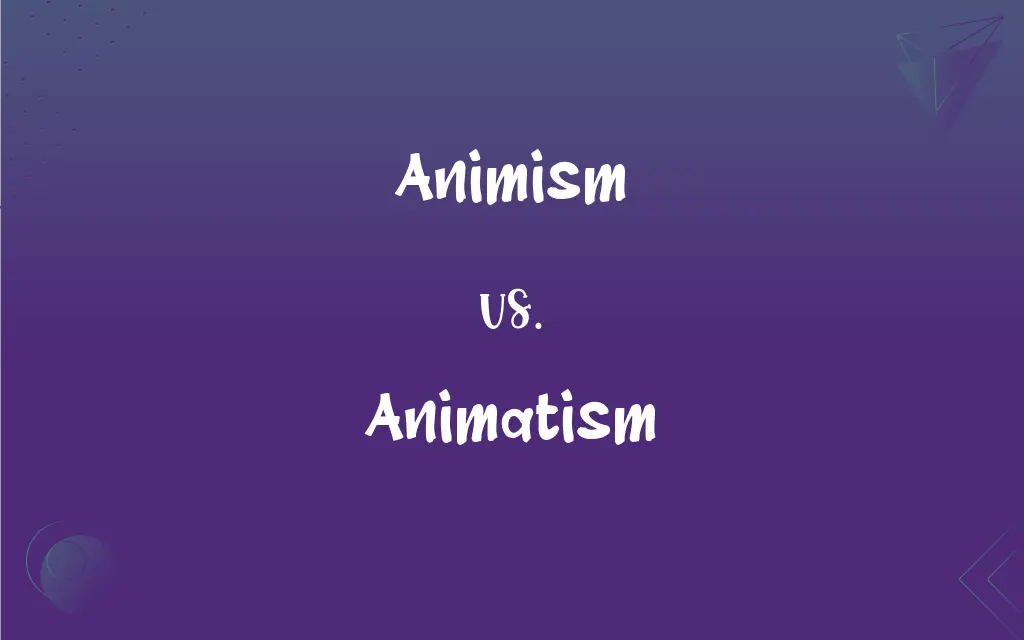Animism vs. Animatism: What's the Difference?
Edited by Aimie Carlson || By Janet White || Published on March 3, 2024
Animism is the belief that objects, places, and creatures all possess a distinct spiritual essence, whereas animatism refers to the belief in a generalized, impersonal power present in the environment.

Key Differences
Animism is a religious belief that attributes a spiritual essence to animals, plants, inanimate objects, and natural phenomena. This worldview sees the universe as being full of spiritual beings. In contrast, animatism focuses on an impersonal force or power that people believe resides in some objects and people, not necessarily embodying them as spirits or deities.
Animism often involves the worship or reverence of spirits associated with natural elements and entities, suggesting a world where everything is alive and interconnected. Animatism, however, conceptualizes power as an abstract, non-personified force that can influence outcomes and circumstances, without the necessity of worshiping these forces as entities.
In animism, rituals and practices are typically aimed at communicating with, appeasing, or managing the spirits within objects or natural phenomena. Animatism, on the other hand, might involve rituals to harness or direct the impersonal power for personal or community benefit, without the interaction with spirits.
The belief system of animism can lead to a rich tapestry of myths, legends, and cultural practices that personify the natural world and its elements. Conversely, animatism might not necessitate a vast mythology but rather focuses on the understanding and manipulation of the impersonal forces.
Understanding animism and animatism highlights the diversity of human spirituality and the various ways cultures interpret the forces of nature and the universe. While animism personalizes the natural world with spirits, animatism deals with the power within those elements in a more abstract form.
ADVERTISEMENT
Comparison Chart
Concept
Belief in spirits residing in objects and natural phenomena
Belief in an impersonal force or power in the environment
Focus
Spiritual beings and entities
Impersonal power or energy
Interaction
Worship, communication, and appeasement of spirits
Manipulation or use of power without personification
Cultural practices
Rituals aimed at spirits
Rituals aimed at harnessing power
Philosophical approach
Personal and relational
Abstract and utilitarian
ADVERTISEMENT
Animism and Animatism Definitions
Animism
Animism is a foundational element of many indigenous religions.
Our animism rituals connect us with the ancestors and the land.
Animatism
Belief in a generalized, impersonal power in the world.
In animatism, the shaman channels the forest's energy for healing.
Animism
The belief in the spiritual essence of all entities.
Through animism, we treated the forest as a living, breathing entity.
Animatism
Animatism views power as omnipresent but not personified.
Animatism explains our luck as the influence of unseen forces.
Animism
Animism recognizes a soul or spirit in every object.
According to animism, even rocks have spirits that can influence our lives.
Animatism
Animatism involves manipulating natural forces for human benefit.
Through animatism, we learn to harness the wind's power for our sails.
Animism
Animism integrates the spiritual with the physical world.
Animism led our tribe to seek guidance from the river's spirit.
Animatism
Animatism is rooted in the belief of an abstract energy.
Animatism led him to believe in the power of positive thinking.
Animism
Animism fosters a deep respect for nature's interconnectedness.
Animism teaches us to honor every leaf and breeze as sacred.
Animatism
Animatism distinguishes between power possessed and power applied.
Her success in animatism was attributed to understanding the earth's energies.
Animism
The belief in the existence of individual spirits that inhabit natural objects and phenomena.
Animatism
A belief that all animate and inanimate objects are infused with a common life force.
Animism
The belief in the existence of spiritual beings that are separable or separate from bodies.
Animatism
(anthropology) The belief that everything is pervaded with a life-force giving each inanimate object a consciousness or personality, but not a soul as in animism.
Animism
The hypothesis holding that an immaterial force animates the universe.
Animatism
The attribution of consciousness and personality to natural phenomena such as thunderstorms and earthquakes and to objects such as plants and stones
Animism
A belief that spirits inhabit some or all classes of natural objects or phenomena.
Animism
A belief that an immaterial force animates the universe.
Animism
(dated) A doctrine that animal life is produced by an immaterial spirit.
Animism
The doctrine, taught by Stahl, that the soul is the proper principle of life and development in the body.
Animism
The belief that inanimate objects and the phenomena of nature are endowed with personal life or a living soul; also, in an extended sense, the belief in the existence of soul or spirit apart from matter.
Animism
The doctrine that all natural objects and the universe itself have souls;
Animism is common among primitive peoples
FAQs
Can animatism and animism coexist in a single belief system?
Yes, some cultures integrate both beliefs, recognizing spirits (animism) and an impersonal force (animatism) in their worldview.
What is animism?
Animism is the belief that all entities in the universe, including animals, plants, and inanimate objects, possess a spiritual essence.
How does animism influence artistic expression?
Animism can deeply influence art, inspiring works that embody the belief in the spirit of all things.
What is animatism?
Animatism is the belief in a generalized, impersonal power that pervades the environment, not necessarily associated with spirits.
How do animism and animatism differ in their view of the natural world?
Animism sees the natural world as filled with spirits, whereas animatism views it as imbued with an impersonal force.
How do practitioners of animism interact with the natural world?
Practitioners of animism often engage in rituals to communicate with or appease spirits within the natural world.
How does animism affect environmental attitudes?
Animism can foster a profound respect for nature, promoting conservation and sustainable living practices.
How do modern societies view animism and animatism?
While often associated with indigenous or traditional cultures, elements of animism and animatism can be found in contemporary spiritual practices.
What role does animatism play in cultural practices?
Animatism often involves rituals aimed at harnessing or directing impersonal powers for specific outcomes.
Do animism and animatism require faith in a higher deity?
Not necessarily; both can exist within polytheistic, monotheistic, or non-theistic frameworks.
Is animatism related to magic or witchcraft?
Animatism can be related to practices considered magical, where manipulating unseen forces is a key element.
How do children in animistic cultures learn about their environment?
Children are often taught through stories and rituals that instill a sense of respect and responsibility towards the natural world.
Are animism and animatism exclusive to certain regions?
No, variations of animism and animatism can be found in diverse cultures around the world.
In what ways is animatism utilized in daily life?
Animatism may influence practices such as healing, where manipulating impersonal forces is believed to restore balance.
Can animatism be applied to modern environmentalism?
Yes, the concept of a pervasive life force in animatism can inspire holistic environmental stewardship.
What scientific perspectives exist on animism and animatism?
Some scientists and anthropologists view animism and animatism as ways humans historically conceptualized their relationship with the natural world.
How do animism and animatism address the concept of death?
Animism may involve rituals to honor the spirits of the deceased, while animatism might focus on the energy transition at death.
What ethical considerations arise from animism?
Animism encourages ethical interactions with the environment, emphasizing respect for all forms of life.
What challenges do practitioners of animism and animatism face today?
They may face challenges from modernization, loss of cultural heritage, and misunderstanding or marginalization by dominant cultures.
Can animism be considered a form of religion?
Yes, animism is often considered a type of religion, emphasizing spiritual connections with the natural world.
About Author
Written by
Janet WhiteJanet White has been an esteemed writer and blogger for Difference Wiki. Holding a Master's degree in Science and Medical Journalism from the prestigious Boston University, she has consistently demonstrated her expertise and passion for her field. When she's not immersed in her work, Janet relishes her time exercising, delving into a good book, and cherishing moments with friends and family.
Edited by
Aimie CarlsonAimie Carlson, holding a master's degree in English literature, is a fervent English language enthusiast. She lends her writing talents to Difference Wiki, a prominent website that specializes in comparisons, offering readers insightful analyses that both captivate and inform.
































































